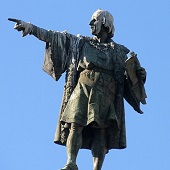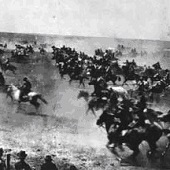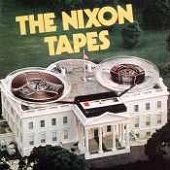
|

|

|

|
  |
The arrival of Europeans in the Western Hemisphere, ignited by Christopher Columbus's accidental discovery of "new" land in 1492, brought on a clash of cultures commonly referred to as the "Columbian Exchange." It was the circa 1500 version of the natural occurence in history any time two foreign cultures come into contact for the very first time. It involves swap of tangible things (such as animals, crops, pottery, weapons, and so forth), ideas and technology (such as farming know-how, military strategy, and so forth), and germs (bacteria and disease, in other words). The results are always mixed, with plenty of positive and negative outcomes (some short-term and others long-lasting). Within 50 years of Spanish arrival, the native population in Hispaniola (present-day Dominican Republic and Haiti) declined from 1 million to perhaps as few as 200. Although unfortunate, the decimation was not intended genocide. While a good portion of the natives were victims of armed aggression and many others were enslaved, the loss of life owing to infectious disease was unavoidable (unless, of course, there was never to be a meeting of peoples in Europe with peoples of the Americas). To think that Columbus somehow embraced a mission of extermination as the underlying objective of his trans-Atlantic voyage is skewed reasoning. |
  |
The most famous battle of the War of 1812, General Andrew Jackson's decisive victory over the British at New Orleans, had nothing to do with the actual end of the war. Peace had already been solidified by the Treaty of Ghent signed on Christmas Eve of 1814, a full two weeks before the battle occurred. Contrary to popular belief, the Battle of New Orleans was not the crushing blow that forced Great Britain to throw in the towel. The real significance of the battle was revealed several years later. Because the overwhelming victory instantly transformed Jackson into a national war hero, it essentially served as his campaign for the presidency (his 1824 bid for the White House fell short, but in 1828 "Old Hickory" became America's seventh President). In the fall of 1814, some 10,000 Redcoats headed toward New Orleans. Once there, the British forces proded through a maze of swamps and bayous, initially undetected by Jackson. On January 8, the British launched an all-out frontal assault against Jackson's significantly smaller force of 4,500. When the fighting stopped, the British had suffered 2,100 casualties (another 500 soldiers were taken prisoner); Jackson's losses were miniscule—eight dead and 13 wounded for a mere total of 21 casualties (even fewer according to some sources). And, had some of the Americans not been so overzealous (they vaulted over the parapet and chased the retreating enemy forces), the American casualty numbers would have been even less! The Battle of New Orleans was made famous by singer Johnny Horton's song of the same title, which reached number 1 on the Billboard Hot 100 in 1959. The words of the catchy tune are those of Jimmy Driftwood, a school principal in Arkansas, who sought a unique way to boost his students' interest in learning history. |
  |
America's settlement westward following the Civil War resulted in formation of several states. By the turn of the century, the United States consisted of 45 states, leaving three statehoods (Oklahoma, 1907; Arizona and New Mexico, 1912) yet to be granted. Oklahoma's statehood was delayed somewhat because the land was originally designated, prior to the Civil War, as a huge Indian reservation (it is the destination for the infamous "Trail of Tears" forced removal of the so-called "Five Civilized Tribes" of southeastern United States during the 1830s). But in 1889, the federal government changed its mind and Indian Territory (as it was called) was opened to immediate white settlement. The method of settlement was a land rush, announced in advance. At 12:00 noon on April 22 an estimated 50,000 people were assembled at the starting line to race for their piece of two million free acres. (A number of individuals entered the unoccupied land early—"Sooners"—and hid there until the legal entrants approached, to time perfectly their claim to the particularly choice homesteads.) At the cannon-blast signal, soon-to-be homesteaders dashed on horseback, aboard wagons, on foot, and even riding bicycles. Between noon and sundown on April 22, the town of Guthrie, with a population of 10,000, was created. It initially operated as a tent city, but within several days buildings were constructed to house banks, stores, and other businesses. According to the 2010 census, Guthrie's current population is 10,191. So after it grew from dirt to 10,000 in half a day, it took another 120 years to net a population increase of less than 200! |
  |
The Spanish-American War (1898) was the shortest and most popular in United States history, prompting Secretary of State John Hay to call it "a splendid little war." In simple terms, it was about Cuban independence from Spain, although explanation of American involvement certainly goes beyond simple benevolence. The war was fought in two theaters—the Pacific and the Caribbean. In both arenas, American military action was equally quick and decisive. At Manila Bay (Philippines) on May 1, Commodore George Dewey commanded utter destruction of the Spanish fleet. Within five hours, all ten Spanish warships were sunk, including nearly 400 casualties. American losses totaled one sailor, who was not even a true battle casualty—he died from heat stroke. On July 3, Admiral William T. Sampson enjoyed similar overwhelming success in Santiago Harbor (Cuba). Over just four hours of battle, all seven Spanish warships were lost with a total of almost 500 casualties. American losses? One killed and one wounded. Collectively, then, within a few hours of gunfire exchange, the American navy destroyed 17 enemy warships (including about 850 casualties) while suffering a mere three casualties (two dead; one wounded). In the words of one historian, the engagements of Dewey and Sampson were "more a practice shoot than a battle." Indeed, the Manila Bay action was such a yawner that Dewey even took time out in the midst of the fray to serve his men breakfast! |
  |
Three presidential administrations, those of Ulysses S. Grant, Warren Harding, and Richard Nixon, have oozed corruption. The Nixon impropriety is distinct for two important reasons. Whereas Grant and Harding were not personally involved, Nixon was a willing participant. And, while the dishonesty of the Grant and Harding presidencies (as examples, the Whiskey Ring and Teapot Dome, respectively) were at the base level about money, the Watergate scandal representad a lust for political power. That fact, coupled with the high degree of Nixon's involvement, is alarming. (Whether or not Nixon approved the initial action is unknown; his knowledge of the crime, within just three days, is confirmed). From nothing more than an apparent "third-rate burglary" (Nixon's words) at the Democratic National Headquarters in Washington's Watergate office complex, the case ballooned into a "national nightmare" (words of President Gerald Ford, Nixon's successor). The scandal was solved by a combination of dogged investigative journalism by the Washington Post (namely reporters Bob Woodward and Carl Bernstein); a secret informer called "Deep Throat" (named after a popular current pornographic movie of the same title); numerous Oval Office tapes (eventually secured from Nixon's grasp through United States v. Nixon); and damning turncoat testimony by one of Nixon's pawns (White House counsel John Dean). So absorbed in corruption was the Nixon administration that more than 40 officials—the Vice-President, four Cabinet officiers, and several top White House aides, among others—would be named in criminal indictments (some apart from Watergate), sooner or later. The charges included obstruction of justice, fraud, extortion, burglary, perjury, violation of campaign funding laws, illegal wiretapping, destruction of evidence, and conspiracy to commit illegal acts. Nixon would not be subjected to judiciary action; in August of 1974 evidence and circumstances against him were so insurmountable that he resigned (the first President ever to do so) rather than face certain removal from office as a result of impending impeachment proceedings. |
